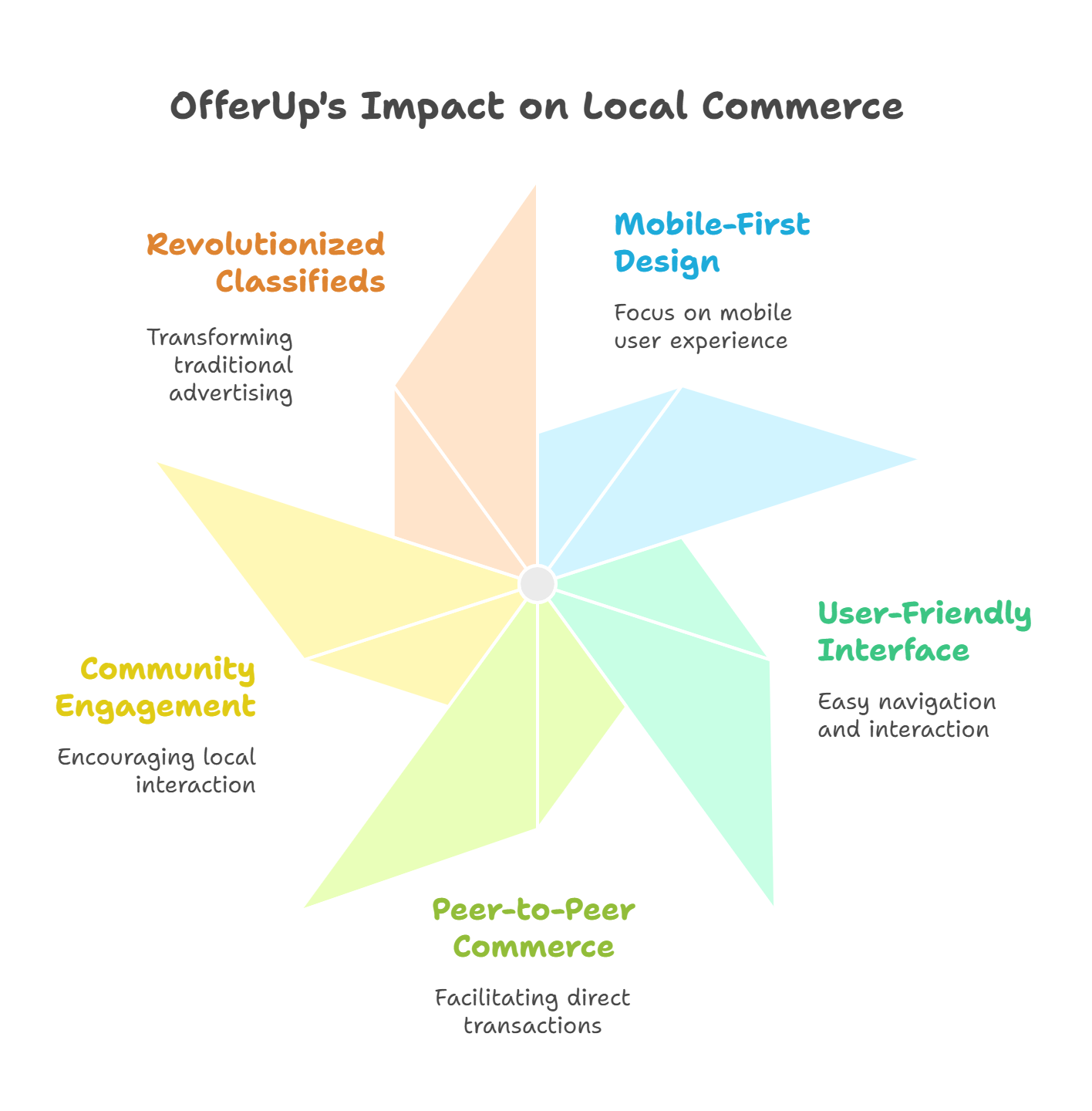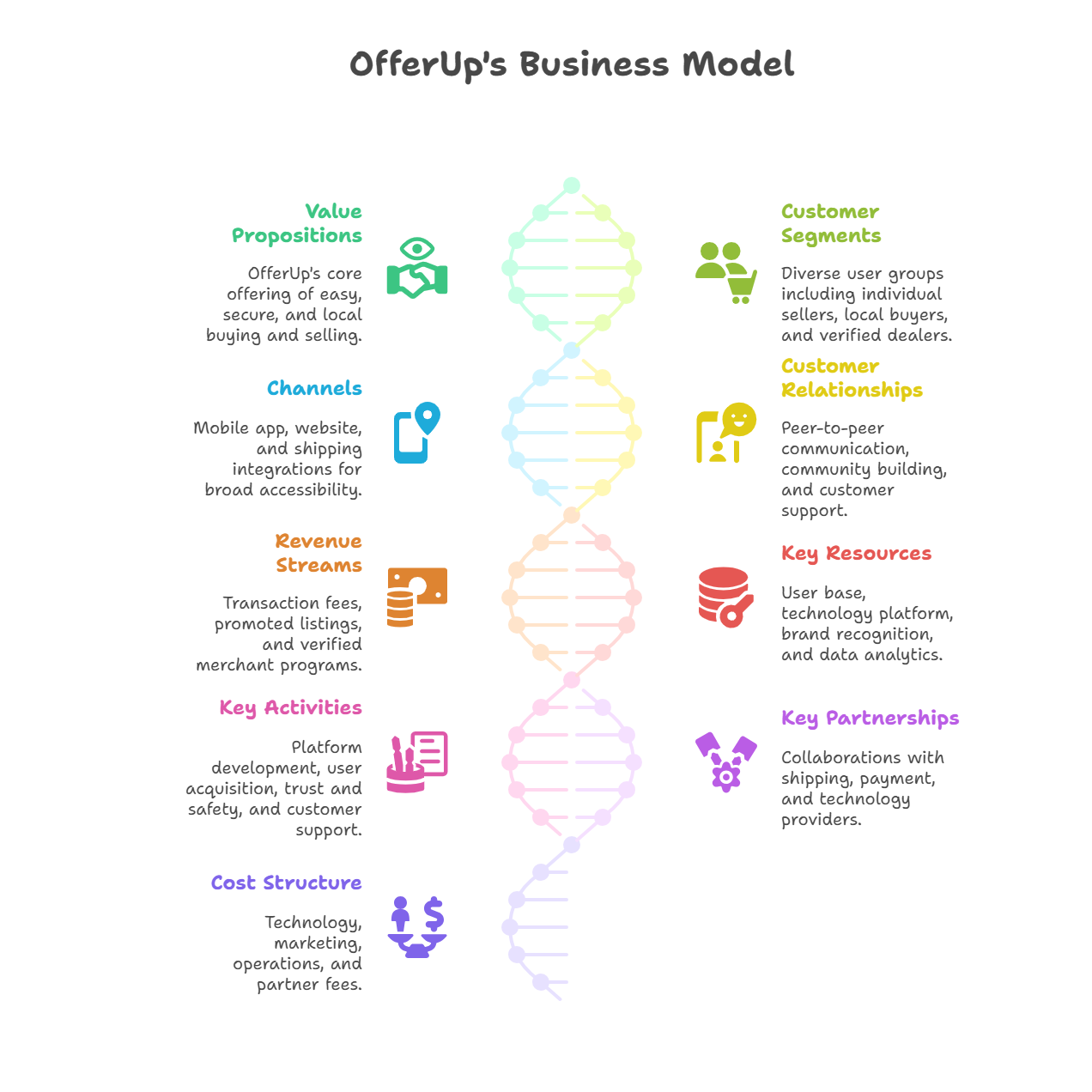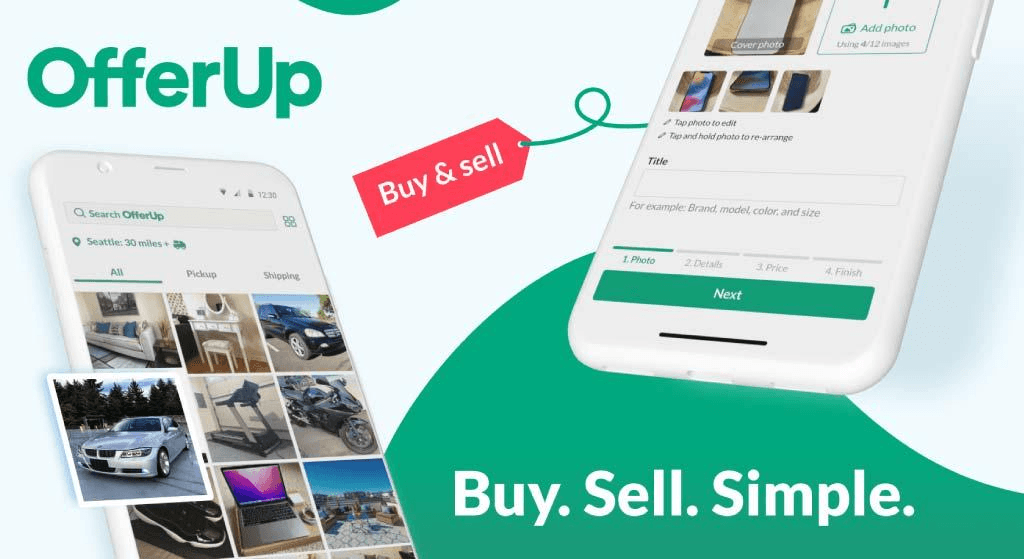How does OfferUp make money? OfferUp Business Model Analysis

OfferUp has emerged as one of the leading mobile-first peer-to-peer marketplaces for buying and selling used goods in the United States. With millions of users actively trading everything from furniture to electronics, the platform has created a thriving ecosystem for local commerce. But this raises an important question: how does OfferUp make money? Understanding OfferUp’s revenue model provides valuable insights into the broader peer-to-peer marketplace economy and reveals the strategic decisions that have shaped this popular platform.
This comprehensive analysis will explore OfferUp’s platform fundamentals, conduct a deep dive into its business model using the business model canvas framework, examine its detailed revenue streams, assess its financial viability, and address frequently asked questions about its monetization strategy. By the end of this article, you’ll have a complete understanding of how OfferUp generates revenue and sustains its operations in the competitive marketplace landscape.
>> You may also like:
What is OfferUp?
OfferUp is a mobile-first marketplace that revolutionized local buying and selling by making it easier for people to discover, buy, and sell items within their communities. Founded in 2011 by Nick Huzar and Arean van Veelen in Bellevue, Washington, the platform was designed to address the limitations of traditional classified advertising by providing a more user-friendly, mobile-optimized experience for peer-to-peer commerce.
Key milestones and statistics that highlight OfferUp’s growth include:
- Founded in 2011 as a mobile marketplace focused on local buying and selling
- Over 20 million monthly active users as of 2021, making it one of the largest mobile marketplaces in the US
- Available nationwide with particularly strong presence in major metropolitan areas
- Mobile-first approach with over 90% of transactions initiated through the mobile app
- $14 billion+ in transaction volume facilitated since launch
- Expansion into shipping services, allowing users to buy and sell items beyond their local area
- Integration with major shipping partners including USPS and UPS for nationwide delivery options
- Over 1,600 Community MeetUp Spots partnered with local police departments for safe transactions
The platform’s success stems from its focus on creating a trusted, convenient environment for local transactions while gradually expanding into nationwide shipping capabilities. This foundation sets the stage for understanding how OfferUp has developed multiple revenue streams to monetize its massive user base and transaction volume.

OfferUp Business Model Canvas Deep Dive Analysis
To understand how does OfferUp make money, we need to examine its business model comprehensively. The business model canvas framework provides a structured approach to analyzing the key components that drive OfferUp’s success and revenue generation. This framework examines nine essential building blocks that collectively explain how OfferUp creates, delivers, and captures value.
Value Propositions
OfferUp’s core value proposition centers on providing a mobile-first, intuitive platform that simplifies the process of buying and selling used goods locally. The platform addresses key pain points in traditional classified advertising by offering:
- For Sellers: Easy listing creation with photo uploads, automated location detection, built-in messaging system, and options for both local pickup and nationwide shipping. The platform also provides seller verification features and promotional tools to increase listing visibility.
- For Buyers: Sophisticated search and filtering capabilities, location-based results, secure messaging with sellers, buyer protection for shipped items, and access to a vast inventory of pre-owned goods at competitive prices.
- Trust and Safety Features: OfferUp emphasizes community safety through verified profiles, community meetup spots in partnership with local police departments, user ratings and reviews, and TruYou verification system that confirms user identities.

OfferUp business model highly focuses on mobile-first strategy
Customer Segments
OfferUp serves multiple distinct customer segments, each with unique needs and behaviors:
- Individual Sellers: Regular consumers looking to declutter homes, sell items they no longer need, or generate extra income through reselling. This segment includes occasional sellers who list items sporadically and power users who regularly flip items for profit.
- Local Buyers: Cost-conscious consumers seeking bargains on used goods, environmentally conscious shoppers interested in extending product lifecycles, and collectors looking for specific vintage or hard-to-find items.
- Verified Dealers: Professional sellers including small businesses, independent retailers, and high-volume individual sellers who treat OfferUp as a significant sales channel. This segment has grown substantially and represents a key revenue opportunity.
Channels
OfferUp’s channel strategy is deliberately focused and streamlined:
- Mobile Application: The primary channel serving over 90% of users, available on iOS and Android platforms with continuous updates and feature enhancements.
- Website Platform: Secondary channel providing desktop access for users who prefer larger screens for browsing or managing multiple listings.
- Shipping Integration: Partnership with shipping providers enables nationwide transactions, expanding the platform’s reach beyond local markets.
Customer Relationships
OfferUp facilitates relationships between buyers and sellers while maintaining platform oversight:
- Peer-to-Peer Communication: Built-in messaging system allows direct negotiation between buyers and sellers, with OfferUp monitoring for safety and policy compliance.
- Community Building: Features like user profiles, ratings, and reviews create a sense of community and accountability among users.
- Customer Support: Dedicated support team handles disputes, provides guidance on platform policies, and assists with technical issues.
- Safety Initiatives: Continuous investment in fraud prevention, user verification, and community safety programs builds trust and encourages repeat usage.
Revenue Streams
This is where we address the central question of how does OfferUp make money. The platform has developed multiple revenue streams:
- Transaction Fees: OfferUp charges sellers fees on shipped items, typically a minimum of $1.99 or 12.9% of the sale price, whichever is higher.
- Promoted Listings: Sellers can pay to increase their listing visibility through various promotion options.
- Verified Merchant Program: Professional sellers pay for verification status and access to advanced selling tools.
- Advertising and Partnerships: Revenue from strategic partnerships and potential advertising placements.
Key Resources
OfferUp’s most valuable resources include:
- User Base: The network effect created by millions of active buyers and sellers is OfferUp’s most critical asset.
- Technology Platform: Sophisticated mobile application, backend infrastructure, and algorithms for search, recommendations, and fraud detection.
- Brand Recognition: Strong brand presence in the mobile marketplace category with high user awareness and trust.
- Data and Analytics: Valuable insights into user behavior, pricing trends, and market demand patterns.
Key Activities
OfferUp’s core operational activities focus on:
- Platform Development: Continuous improvement of mobile and web applications, including new features and performance optimization.
- User Acquisition and Retention: Marketing campaigns, referral programs, and user experience enhancements to grow and maintain the user base.
- Trust and Safety: Fraud prevention, user verification, policy enforcement, and community safety initiatives.
- Customer Support: Providing assistance to users, resolving disputes, and maintaining high satisfaction levels.
Key Partnerships
Strategic partnerships enable OfferUp’s expansion and service enhancement:
- Shipping Partners: Collaboration with USPS and other carriers facilitates nationwide shipping capabilities.
- Payment Processors: Integration with secure payment systems ensures smooth financial transactions.
- Local Communities: Partnerships with police departments and community organizations support safe meetup locations.
- Technology Providers: Relationships with cloud infrastructure, analytics, and security service providers.
Cost Structure
OfferUp’s primary cost categories include:
- Technology and Development: Software development, platform maintenance, cloud infrastructure, and cybersecurity measures.
- Marketing and User Acquisition: Digital advertising, promotional campaigns, and referral program costs.
- Operations: Customer service, trust and safety operations, and general administrative expenses.
- Partner Fees: Commission payments to shipping partners, payment processors, and other service providers.

How does OfferUp make money? Detailed Revenue Streams
Now that we’ve examined OfferUp’s overall business model, let’s dive deeper into the specific ways how does OfferUp make money. The platform has evolved its monetization strategy over time, transitioning from a free service to a multi-revenue stream model that balances user experience with sustainable profitability.
Transaction Fees
Structure and Rates: When sellers choose to ship items to buyers, OfferUp charges a service fee that varies by item category and sale price. The current fee structure includes:
- A service fee ranging from 12.9% to 15.4% of the sale price depending on the item category
- Payment processing fees of approximately 2.9% + $0.30 per transaction
- Shipping costs are paid separately by buyers
Service Coverage: The transaction fee covers payment processing, customer support, buyer protection services, and platform maintenance. This bundled approach simplifies the selling process while ensuring OfferUp captures value from the services it provides.
Eligibility Requirements: Items must meet specific criteria for shipping eligibility, including size limitations (typically under 20 pounds), prohibited item restrictions, and category guidelines to ensure safe and efficient shipping operations.
Revenue Impact: Transaction fees represent the largest portion of OfferUp’s revenue, particularly as more users adopt shipping over local pickup to expand their buying and selling reach nationwide.
Promoted Listings
- Promote Feature: Basic promotion service allows sellers to boost their listings to appear higher in search results for their local area. Pricing typically ranges from $1.99 to $9.99 depending on the item category and local market competition.
- Promote Plus: Enhanced promotion service provides greater visibility, including placement in premium positions and extended geographic reach. This subscription-based service costs approximately $19.99 per month and allows sellers to promote multiple listings.
- Bump Feature: Sellers can “bump” their listings to refresh them in search results, typically costing $0.99 to $2.99 per bump depending on the item category.
- Performance Tracking: OfferUp provides sellers with analytics on their promoted listings, showing views, inquiries, and other engagement metrics to demonstrate value and encourage repeat promotion purchases.
Verified Merchant Program
- Professional Seller Services: The Verified Merchant Program caters to high-volume sellers, small businesses, car dealers, and professional resellers who want enhanced credibility and access to advanced tools.
- Verification Benefits: Verified merchants receive special badges, priority customer support, advanced analytics dashboard, bulk listing tools, and potentially favorable algorithm treatment in search results.
- Fee Structure: Merchants pay monthly or annual subscription fees that vary by seller type and volume, ranging from approximately $49.99 per month for general merchants to higher tiers for auto dealers and high-volume sellers.
- Growth Opportunity: As more professionals recognize OfferUp’s potential as a sales channel, this program represents a growing revenue stream with higher per-user value.
Advertising and Partnerships
- In-App Advertising: OfferUp generates revenue through sponsored listings and banner advertisements from relevant brands and services targeting specific user demographics and behaviors.
- Strategic Partnerships: Revenue sharing agreements with shipping partners, payment processors, and service providers who benefit from access to OfferUp’s user base.
- Affiliate Commissions: Potential earnings from partnerships with related services such as moving companies, storage facilities, or cleaning services.
- Data Insights: Anonymized market data and consumer behavior insights could become additional revenue streams through partnerships with research firms or brands seeking market intelligence.
Future Revenue Opportunities
- Subscription Services: Potential premium seller subscriptions offering advanced analytics, priority support, and enhanced listing features.
- Financial Services: Partnerships with lending companies or payment platforms to offer seller financing or buyer payment plans.
- Insurance Products: Collaboration with insurance providers to offer item protection plans for high-value transactions.
OfferUp Financial Overview and Business Model Viability
Understanding how does OfferUp make money requires examining its financial performance and long-term viability. While OfferUp is a private company and doesn’t publish detailed financial statements, available information and industry analysis provide insights into its revenue trends and business sustainability.
Revenue Growth
OfferUp has demonstrated consistent revenue growth since implementing its fee structure in 2016. Key growth drivers include:
- User Base Expansion: Continued growth in monthly active users from 20 million in 2021 to over 56 million in 2024, directly correlating with increased transaction volume and revenue potential.
- Transaction Volume Growth: As users become more comfortable with online transactions and shipping services, the percentage of fee-generating transactions has increased significantly.
- Average Transaction Value: The platform has seen growth in the average value of transactions, particularly in shipped items, which directly increases transaction fee revenue.
- Geographic Expansion: OfferUp’s expansion into rural markets and smaller cities has opened additional revenue opportunities beyond its initial urban focus.
Profitability Status
OfferUp’s estimated annual revenue currently stands at approximately $89.4 million per year as of mid-2025, according to recent data. Previously, company statements and industry reports indicated a range of $100-$150 million in revenue for 2023-2024, reflecting some variability and conservative estimates. However, like many technology platforms, OfferUp faces the challenge of balancing growth investment with profitability:
- Investment in Growth: Significant spending on user acquisition, platform development, and market expansion continues to prioritize growth over immediate profitability.
- Unit Economics: The platform’s revenue per user has shown steady improvement as monetization strategies mature and user engagement increases.
- Operational Efficiency: Ongoing investments in automation and artificial intelligence aim to improve operational efficiency and reduce per-transaction costs.
- Path to Profitability: OfferUp’s diversified revenue streams, growing user base, and improving unit economics position it well for achieving sustainable profitability as it optimizes its cost structure.
Market Position and Competitive Advantage
OfferUp’s ability to generate sustainable revenue depends on maintaining its competitive advantages:
- Mobile-First Design: Superior mobile user experience compared to traditional classified platforms like Craigslist provides a sustainable competitive advantage in an increasingly mobile-centric world.
- Trust and Safety: Extensive investment in user verification, fraud prevention, and community safety creates user loyalty and reduces churn compared to less secure alternatives.
- Network Effects: Large user base creates value for both buyers and sellers, making it difficult for competitors to replicate OfferUp’s marketplace dynamics and liquidity.
- Shipping Integration: Seamless nationwide shipping capabilities differentiate OfferUp from purely local platforms while creating additional revenue opportunities.
- Community Focus: Strong emphasis on local communities and safe meetup locations builds user trust and encourages repeat usage.
FAQs about How Does OfferUp Make Money
What fees does OfferUp charge sellers?
OfferUp charges sellers a transaction fee when items are shipped, with the fee being either $1.99 minimum or 12.9% of the sale price, whichever is higher. Local pickup transactions are free for sellers. Additional fees may apply for promoted listings and verified merchant services.
Does OfferUp charge buyers any fees?
No, OfferUp does not charge buyers any direct fees. Buyers pay only the item price plus any shipping costs that may be included in the listing price. The transaction fees are charged to sellers and typically built into their pricing.
How can sellers increase their listing visibility?
Sellers can increase visibility through OfferUp’s promoted listing options, including Promote and Promote Plus features. These paid services boost listings higher in search results and extend their geographic reach.
How does OfferUp compare financially to competitors like Facebook Marketplace or Craigslist?
Unlike Craigslist (which relies on posting fees in some categories) and Facebook Marketplace (which is largely free), OfferUp monetizes through transaction fees on shipped items and promotional services. This creates a more sustainable revenue model while maintaining free local transactions.
What future monetization strategies might OfferUp explore?
Potential future revenue streams include subscription services for power sellers, expanded advertising options, premium seller tools, and partnerships with financial services companies for seller financing or buyer payment plans.
Is shipping mandatory to use OfferUp?
No, shipping is optional. Sellers can choose local pickup only (free), shipping only, or both options. Many transactions still occur through local meetups, which don’t generate transaction fees for OfferUp.
How safe is it to transact on OfferUp?
OfferUp provides multiple safety features including user verification, community meetup spots, buyer protection for shipped items, and fraud prevention systems. However, users should always follow safety guidelines, especially for local transactions.
This comprehensive analysis reveals that how does OfferUp make money involves a sophisticated multi-stream approach that balances user experience with sustainable revenue generation. Through transaction fees, promoted listings, verified merchant programs, and strategic partnerships, OfferUp has created a viable business model that continues to evolve with market demands and user needs. The platform’s success demonstrates how peer-to-peer marketplaces can successfully monetize while maintaining their core value proposition of connecting local buyers and sellers.


